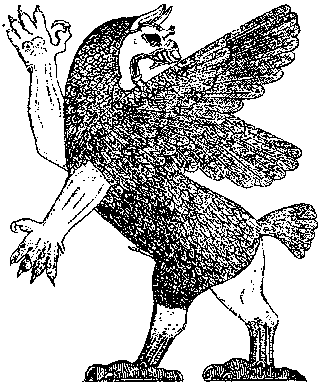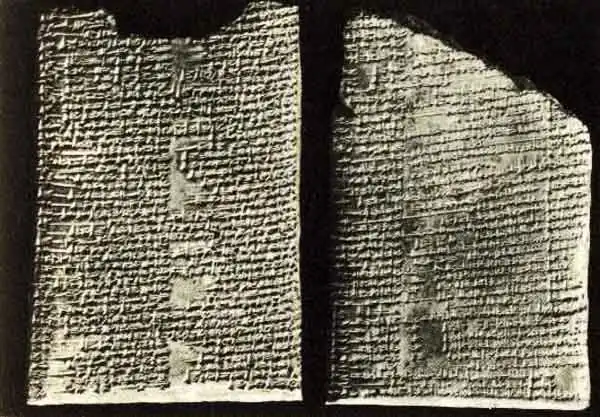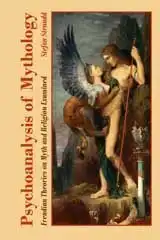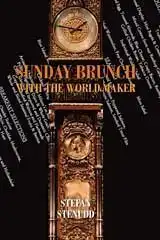
Enuma Elish 3The Babylonian Creation Myth
3 The Enuma Elish SourceThe title Enuma Elish means “when above”, the two first words of the epic. This Babylonian creation story was discovered as late as in the 19th century, among the 26,000 clay tablets found by Austen Henry Layard in the 1840s at the ruins of Nineveh. Enuma Elish was made known to the public in 1875 by the Assyriologist George Adam Smith (1840-76) of the British Museum, who was also the discoverer of the Babylonian epic Gilgamesh. He made several of his findings on excavations in Nineveh.
In a letter to the Daily Telegraph, he presented a summary of the Enuma Elish fragments known by that time. Next year he published the first book about the Enuma Elish text, The Chaldean Account of Genesis. The book is richly illustrated, and specifies already on the title page that it contains: “The description of the creation, the fall of man, the deluge, the tower of Babel, the times of the patriarchs, and Nimrod.” His comparison of Enuma Elish to the Bible’s creation stories caused a wider popular interest than would otherwise have been to expect. In the following years, several additional books on the subject were published, and Babylonian clay tables were searched and investigated in the hope of finding additional fragments of the Enuma Elish epic, which had numerous gaps. In 1902, Leonard William King (1869-1919), an Assyriologist and archaeologist, also in the service of the British Museum conducting its excavations of Nineveh, published a substantial work on the Enuma Elish epic: Enuma Elish. The Seven Tablets of Creation. He had succeeded in finding enough fragments to trace the full story of the epic, although there were still plenty of small gaps. All the Enuma Elish fragments he used were at the British Museum. Additional findings since then have filled almost all of the gaps, except for in the fifth tablet, where several gaps still remain – but not so that the story is in any way uncertain.
 Enuma Elish tablets. The Enuma Elish tablets found so far are mainly from the first millennium BC, and no findings from the second millennium BC contain Enuma Elish. Babylon, with Marduk as its patron god, emerged under the Amorite ruler Sumu-la-el in the years 1936-1901 BC. An earlier dating of the Enuma Elish epic, with Marduk as its hero, is not possible. At the reign of Nebuchadnezzar I in the late 12th century BC, the epic must already have existed for some time. Stephanie Dalley argues for the basic story of the Enuma Elish epic being of Amorite origin, but the last two tablets being added in the Kassite period (16th — 12th century BC). Also L. W. King regards the seventh tablet, honoring Marduk with fifty names, as a later addition to Enuma Elish. At the time of his book, there was no Enuma Elish tablet older than the 7th century BC. Still, he thought that important elements of the creation story could be as old as from the first half of the 3rd millennium BC, and that “the bulk of the poem” was composed no later than 2000 BC. Ola Wikander points to the language of the Enuma Elish epic implying that it got its present form somewhere 1500 — 1000 BC.
The Sumerian influence is evident in the names of several of the gods, as well as in the use of many Sumerian words. The Enuma Elish text is written with a sophistication and learning that points to priesthood, and in such a way that it is clearly intended for reading, not oral transmission. It contains many wordplays that could only be understood by the literate few. Of course, it is still possible that the Enuma Elish text is based on an oral tradition – this is implied by the repetition of long parts of it, and its ritualistic ingredients. Enuma Elish was recited at the Babylonian new year celebration, taking place at the spring equinox. In this rite, the king momentarily lost his royal insignia and was humbled, and then his rights were restored.
4 Enuma Elish: TheoriesEnuma ElishThe Babylonian Creation Myth
This article about the Enuma Elish Babylonian Creation Myth was originally written in the year 2007 for a seminar at the Department of History of Ideas, Lund University, as a part of my dissertation in progress on Creation Myths and their patterns of thought. Transforming the text to webpages, I have excluded footnotes, or edited them into the text.
MENUCreation Myths Around the WorldHow stories of the beginning began.
The Meanings of MythologyTheories through history about myth and fable.
Archetypes in MythsThe mythological symbols and what they stand for.
The Logics of MythPatterns of creation.
CREATION MYTHS IN DEPTHCreation in Rig Veda 10:129The paradox of origin, according to an Indian myth.
Genesis 1The first creation story of the bible scrutinized.
Enuma ElishThe ancient Babylonian creation myth.
Xingu Creation of ManThe insoluble solitude of gods and humans.
ContactAbout Cookies
ON MY OTHER WEBSITESPsychoanalysis of MythWhat Sigmund Freud and C. G. Jung thought about myths, their origins and meanings.
Myth of CreationAn introduction to the subject of creation myths and the patterns of thought they reveal.
Cosmos of the AncientsWhat the Greek philosophers believed about the cosmos, their religion and their gods.
Life EnergyThe many ancient and modern life force beliefs all over the world explained and compared.
TaoisticTaoism, the ancient Chinese philosophy of life explained. Also, the complete classic text Tao Te Ching online.
|
 Archetypes of Mythology
Archetypes of Mythology Psychoanalysis of Mythology
Psychoanalysis of Mythology Cosmos of the Ancients
Cosmos of the Ancients Life Energy Encyclopedia
Life Energy Encyclopedia Sunday Brunch with the World Maker
Sunday Brunch with the World Maker Fake Lao Tzu Quotes
Fake Lao Tzu Quotes Stefan Stenudd
Stefan Stenudd